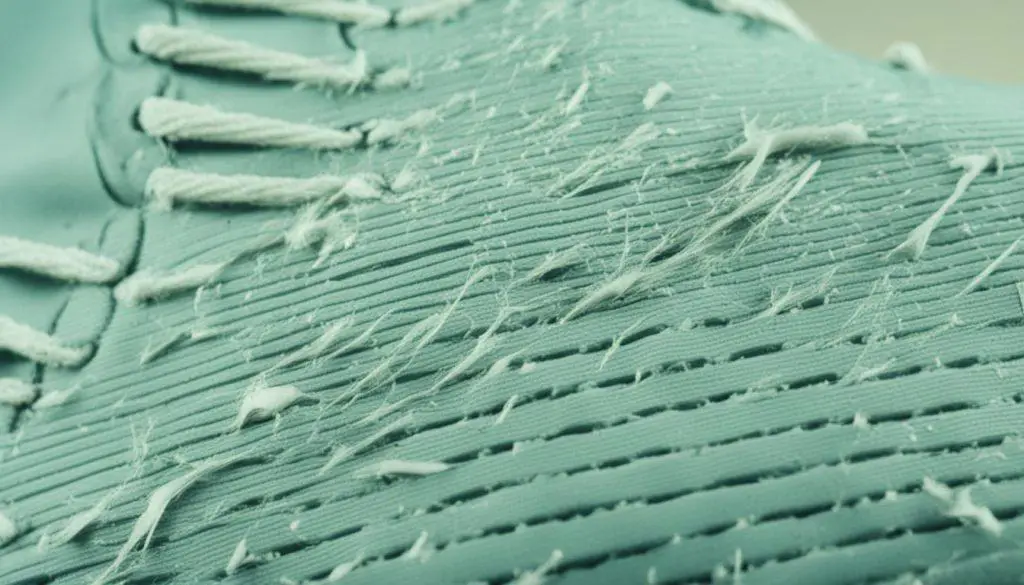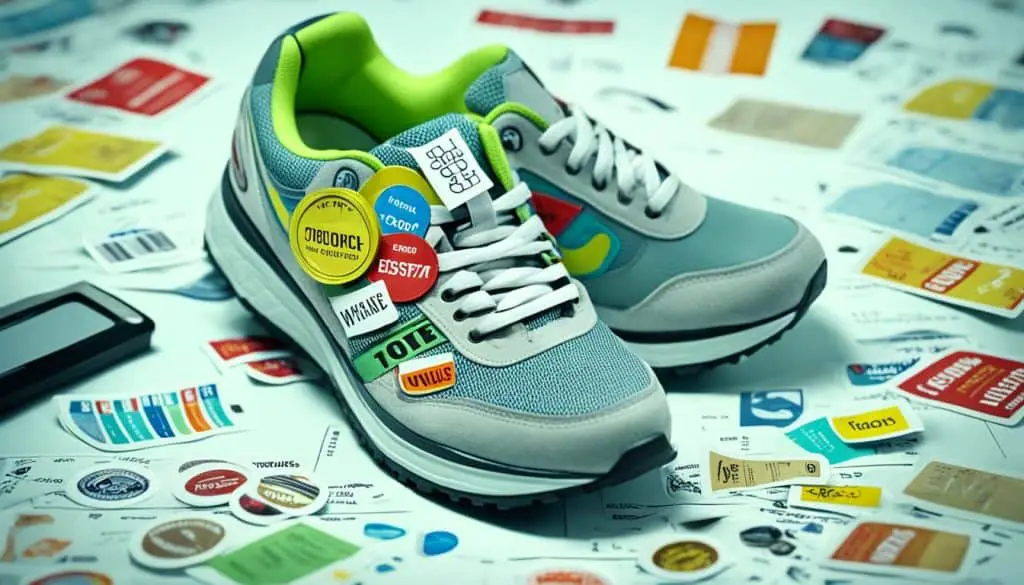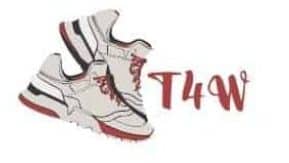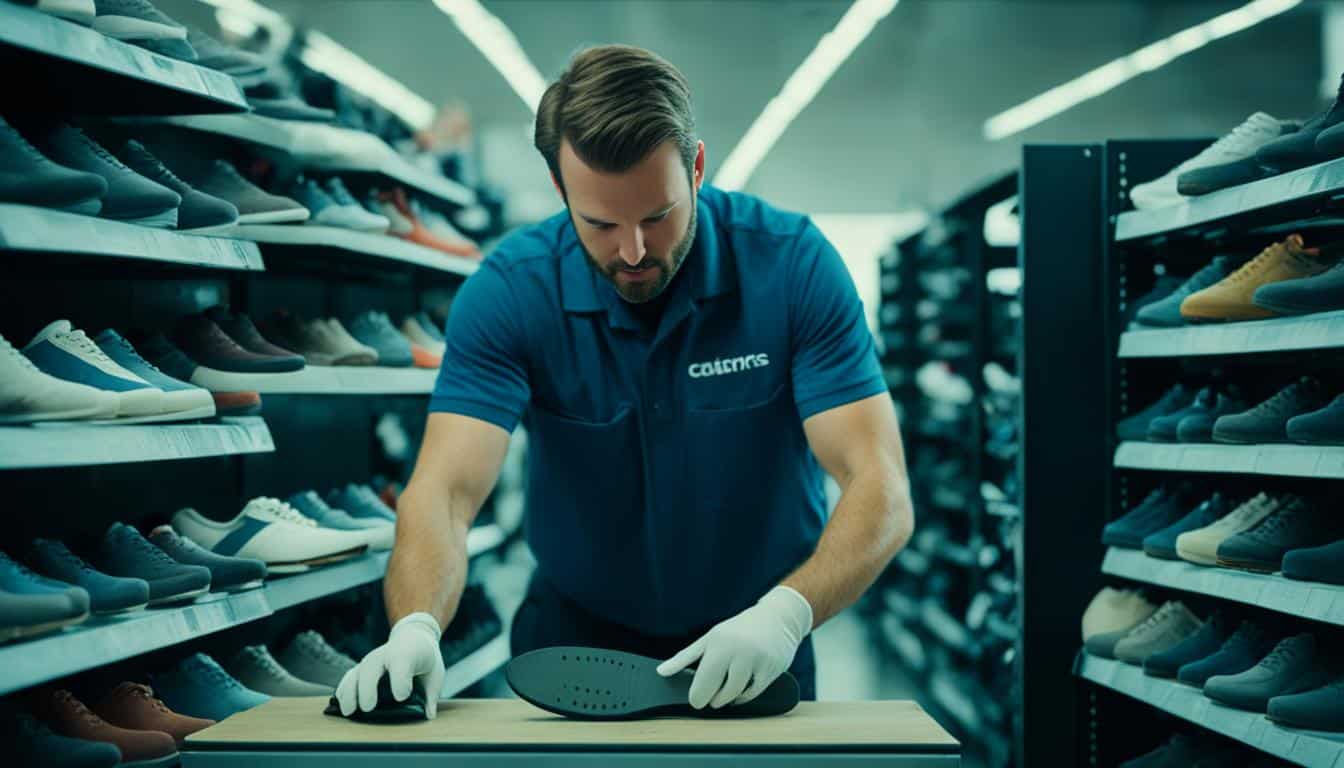Why does it even matter if stores can tell if your shoes have been worn? Well, it all comes down to return policies. Many stores have strict guidelines when it comes to returning shoes, particularly if they have been worn outside the realm of trying them on at home.
By understanding these sneaky signs, you can stay within the unworn realm and avoid any sticky return situations.
Dirt Talks: The Clues on the Soles
Just like a detective looks for clues, stores check the soles of your shoes for dirt or scuffs. If your shoes have been out and about, they might spill the beans by showing off some dirt or marks on the bottom. This is a red flag for store employees because it indicates that your shoes have been worn outside of the store.
When you go on adventures with your shoes, whether it’s a hike in the mountains or a walk in the park, they can pick up dirt and leave behind marks on the bottom.
These signs tell the story of where your shoes have been and give away the fact that they have been used outside of the “unworn realm.” So, even if you try to clean the uppers of your shoes, the soles might still reveal the truth.
Let’s take a closer look at why dirt talks and what it reveals to the keen eyes of store employees:
- Clues from the Great Outdoors: When you wear your shoes outside, they come into contact with various surfaces like grass, mud, concrete, or even gravel. Each of these surfaces leaves behind different types of dirt and marks. Store employees are trained to recognize these clues and can easily spot the signs of outdoor usage by simply examining the soles of your shoes.
- Tracking Your Steps: The dirt on the bottom of your shoes can give away the specific places you’ve been. For example, if you have dirt from a sandy beach on your soles, it’s evident that you’ve taken a seaside stroll. Similarly, if your shoes have traces of red clay, it suggests a hiking adventure in a muddy trail. Store employees pay attention to these details as they try to uncover the story behind your shoes.
- Uncovering the Truth: The dirt and marks on the soles not only reveal that your shoes have been worn outside but also suggest that they might have experienced more wear and tear than expected. This can impact their resale value and the store’s ability to sell them as new. So, while a little dirt may not seem like a big deal to you, it’s a significant clue that store employees can’t ignore.
“The dirt and marks on the soles of your shoes tell a story. They give away where your shoes have been and how much they’ve been used. Store employees are like detectives, examining these clues to determine if your shoes are truly unworn. So, next time you return a pair of shoes, remember that the evidence is right at the bottom of your soles.” – Shoe Expert
Therefore, the dirt talks on the soles of your shoes are a key factor in revealing whether they have been on an adventure or just confined to the store. Store employees pay close attention to these clues and use them to determine the true condition of your shoes.
So, if you want to keep your returns within the unworn realm, make sure to keep an eye on your soles and avoid taking your shoes out and about before making a return.
Crease, Please: The Whisper of Worn Shoes
Have you ever noticed those lines that appear across the top of your shoes after you’ve worn them a bit? Stores look for these creases, which are like the shoes whispering, “Yep, we’ve been walking!” We’ll dive into why these creases are a giveaway that your shoes have been worn.
Inside Story: Uncovering Foot Imprints
The inside of your shoes holds the secrets of their journey. Stores have a keen eye for foot imprints and signs of a well-worn insole. These hidden foot buddies tell a tale that your shoes weren’t simply confined to the box. Let’s dive into how store employees outsmart worn shoes by uncovering the inside story.
“Every step leaves a mark, revealing the true story of your shoes.”
When examining the insole, store employees look for unique foot imprints that give away a shoe’s usage. These imprints, like individual foot buddies, create distinct patterns that cannot be easily erased. They are the foot’s personal stamp, marking its passage through time and adventure.
Take a closer look at the image above to see the intriguing foot imprint left on a well-worn insole. It’s undeniable evidence of the foot’s presence and the footsteps taken in those shoes. Store employees analyze these imprints to determine whether the shoes have truly been worn or if they’ve only been resting peacefully inside the box.
Unmasking Foot Imprints: The Store’s Footprint Detective Work
Stores employ a meticulous approach to decipher the foot imprints ingrained in your shoes’ insoles. By comparing these imprints to the expected pattern of an unworn shoe, store employees can quickly identify any discrepancies and tell if your shoes have truly been on an adventure.
Let’s discover how store employees unmask foot imprints and expose the true story of your shoes.
| Signs of Worn Shoes | Signs of Unworn Shoes |
|---|---|
| • Visible foot imprints on the insole | • Clean and unmarked insole |
| • Unique patterns of foot imprints | • Uniform and consistent insole |
| • Worn-out impressions of the arch and heel | • Pristine and intact arch and heel areas |
This table highlights the stark contrasts between worn and unworn shoe insoles. Store employees meticulously compare the foot imprints found in your shoes to the characteristics of an unworn shoe, carefully analyzing their shape, depth, and wear patterns.
By doing so, they can quickly determine if your shoes have truly ventured outside or are still in the realm of the unworn.
The inside story of your shoes is revealed through these foot imprints and insole examinations, leaving no doubt in the minds of store employees about their usage.
With the uncovering of foot imprints, our journey through the signs stores spot to tell if your shoes have been on an adventure is nearly complete. Let’s move forward to the next section, where we explore the wear and tear that gives away the secrets of your shoes’ past.
Wear and Tear: Signs of Usage
Even a little wear and tear on the heel or sides of your shoes can be a giveaway that they’ve been through some adventures. Just like your clothes get a bit worn when you play outside, shoes experience the same effects of usage. Stores have trained eyes to detect these signs and determine if your shoes have been worn.
When examining shoes for wear and tear, store employees pay close attention to the areas that typically show the most damage. These include the heel and the sides of the shoes, which easily accumulate scuffs, scratches, and other visible marks.
“The worn-out heel and scuffed sides are like little stories written on your shoes. They provide valuable hints about the adventures your shoes have been on,” explains Lisa Thompson, a shoe expert at a popular footwear retailer.
If your shoes exhibit notable wear and tear on the heel and sides, it’s an indication that they have been used extensively. The more worn these areas are, the higher the chances of your shoes being classified as “worn shoes” by store employees.

In this image, you can see the visible damage and signs of usage on the heel and sides of the shoes. These indications make it clear to store employees that the shoes have been worn multiple times, potentially disqualifying them from being returned as “unworn.”
Key Takeaways:
- Stores detect wear and tear on shoes by examining the heel and sides for visible damage.
- Scuffs, scratches, and other marks are indicators of usage.
- Worn shoes with significant wear and tear may not be eligible for return.
Smell-o-Meter: The Odor of Adventure
Okay, this might be a bit icky, but shoes pick up smells pretty easily. If the shoes smell like they’ve seen some action (other than sitting in a box), that’s a big hint! We’ll delve into how store employees use their sense of smell to determine if shoes have been worn.
When it comes to detecting worn shoes, store employees trust their noses just as much as their eyes. The smell-o-meter is an essential tool in their arsenal, allowing them to sniff out any odors that suggest the shoes have been on some wild adventures.
Just like a bloodhound on a scent, store employees are trained to pick up on even the faintest whiff of action from a pair of shoes. Whether it’s the fragrance of well-worn sneakers after a workout session or the lingering smell of the great outdoors from hiking boots, the smell-o-meter tells a story that the shoes themselves might not reveal.
But how do they determine if a shoe’s smell indicates genuine wear or if it’s just the result of being in close proximity to other odorous objects in the shoebox? Store employees are experts at distinguishing between regular storage smells and those that suggest the shoes have been actively used.
They can identify the signature scent of perspiration and dirt that accumulates on the insides of shoes after being worn for extended periods. The peculiar combination of sweat, foot odor, and the unmistakable aroma of outdoor excursions can’t be easily masked or mistaken for just sitting idly in a shoebox.
Disguising the Smell: Mission Impossible?
Store employees are well aware that some people might try to mask the smell of worn shoes by using air fresheners or other fragrant products. However, their keen sense of smell enables them to detect any attempts at deception. So, even if you think you can outsmart the smell-o-meter, think again!
The smell-o-meter plays a vital role in ensuring that stores can provide their customers with quality, unworn shoes. By detecting any smells that suggest previous usage, they can uphold their return policies and prevent the sale of shoes that may not meet the expectations of future buyers.
Next time you consider returning a pair of shoes, remember that store employees have more than just their eyes glued to your purchase. They rely on their sense of smell to determine whether the shoes have truly been on an adventure or if they’re just waiting patiently in the shoebox for the right owner.
Sticky Situations: Decoding Stickers and Labels
When it comes to detecting worn shoes, stores pay close attention to every detail, including the stickers and labels on the soles. Stickers and labels provide crucial information about the condition of the shoes and can raise a red flag if they’re missing or damaged.
Stickers or labels on the sole of your shoes should be intact. If they’re missing or look like they’ve been on a rollercoaster ride, it’s a sure sign that the shoes have been through some wear and tear. Store employees are trained to spot these sticky situations, and they understand that missing or damaged stickers can be a red flag.

To help you understand why stickers and labels matter in detecting worn shoes, here’s an example:
Imagine you find a pair of sneakers in the store with a missing sticker on the sole. It’s a bit odd, right? It’s like finding a missing puzzle piece – something just doesn’t match up. Store employees know that a missing sticker on the sole could mean that the shoes were previously worn and the sticker was intentionally removed to hide that fact.
To give you a clearer picture, let’s take a look at the table below:
Stickers/Labels Implication Intact and undamaged The shoes are likely new or have been gently worn. Missing or partially torn A strong indicator that the shoes have been worn and the sticker was intentionally removed or damaged. Illegible or unreadable Difficult to determine the condition of the shoes.
As you can see, the condition of stickers and labels plays a crucial role in determining whether the shoes have been worn or not. Store employees utilize this information as part of their thorough evaluation process.
Next time you’re shopping for shoes, remember that even the smallest details matter. Pay attention to the condition of the stickers and labels on the soles, and make sure they’re intact to avoid any sticky situations when it comes to returning or exchanging your shoes.
Laces Out: The Tale of Frayed Strings
When it comes to detecting worn shoes, store employees pay attention to every detail, right down to your laces. If your laces are frayed or look like they’ve been tied and untied more times than a game of tag, it can raise suspicion.
The condition of your laces can tell a story about how your shoes have been treated. Frayed laces suggest that your shoes have seen extensive use and may not be in pristine condition. The wear and tear on the laces can indicate that your shoes have been through many adventures.
Stores understand that laces can come undone from time to time, but when the laces consistently appear untied and loosely hanging, it can suggest that the shoes have been taken on and off frequently. This behavior is often associated with shoes that have been worn extensively rather than being casually slipped on and off.
Here’s what store employees look for when examining your laces:
| Sign | Explanation |
|---|---|
| Frayed Laces | Indicate extensive use and wear on the shoes. |
| Tied and Untied Laces | Suggest frequent removal of the shoes, indicating potential wear. |
By paying attention to the laces, store employees can gather valuable information about the history of your shoes. So, before returning a pair of shoes, make sure the laces are intact and in good condition.
Next, we’ll explore another crucial factor that stores consider when determining if your shoes have been worn: the condition of the shoebox and packaging.
Boxy Clues: Packaging Tells a Story
When it comes to determining whether shoes have been worn or not, store employees pay attention to every detail—including the shoebox and packaging. These boxy clues can provide valuable insights into the history of the shoes.
If the shoebox is damaged or missing, it raises suspicions that the shoes have been out and about. A pristine, intact shoebox indicates that the shoes have likely remained unworn. On the other hand, a damaged or missing shoebox suggests that they have been handled outside of their original packaging.
This attention to the shoebox may seem meticulous, but it’s just another way for stores to ensure a fair and honest return policy. By examining the shoebox, store employees can piece together the story behind the shoes and determine if they have been previously worn.
Mismatched Mysteries: The Odd Pair
It’s an intriguing puzzle that stores are experts at solving – the mystery of mismatched shoes. While some people attempt to return shoes that don’t quite match up, stores have a keen eye for spotting these curious odd pairs.
Let’s unravel the secrets behind how store employees identify these mismatches and what it means for returning worn shoes.
Uncovering the Mismatched Clues
When it comes to spotting mismatched shoes, stores know how to connect the dots. One of the telltale signs is when one shoe appears newer than the other.
It could be a subtle difference in color, condition, or even slight variations in design details. Stores have trained their eyes to spot these disparities and quickly identify the mysterious odd pair.
The Implications for Returning Worn Shoes
The ability to spot mismatched shoes is not just about solving a puzzling mystery; it also has implications for returns. Stores use this knowledge to ensure that customers don’t try to return mismatched or worn-out shoes as newer pairs.
By carefully examining the shoes and comparing them side by side, store employees can protect the integrity of return policies and ensure fairness for all customers.
| Table: Implications for Returning Mismatched Shoes |
|---|
| Prevents customers from returning worn-out shoes as newer pairs |
| Preserves the integrity of return policies |
| Ensures fairness for all customers |
The Snug Test: Fit Matters
When it comes to determining whether your shoes have been worn or not, stores go the extra mile to conduct the snug test. This final examination involves trying the shoes on a mannequin foot to check the fit and uncover any signs of stretching.
If your shoes are too snug on the mannequin foot, it indicates that they have been stretched out by a human foot. This is a crucial clue for store employees to detect worn shoes and ensure that returns comply with their policies.
The snug test is an integral part of the process as it reveals the true condition of the shoes’ fit. Stores understand that proper fit is essential for customer satisfaction and strive to avoid accepting returns of shoes that have been stretched out or altered from their original condition.
So next time you’re tempted to return those shoes, keep in mind that stores are meticulous in checking for any signs of wear using the snug test.


